 |
||
|
A New Kind of Road Rage
|
||
|
By Penny Turner
Athens News |
||
GEORGE and I were travelling vaguely south, over the Pindos mountains. The idea was to go north to Mount Grammos eventually, but for now we were aiming for Papingo in the Zagorohoria, in Epiros. We had been hoping to travel on the gorgeous tracks that used to cross these mountains, but they are being replaced by truly awful new asphalt roads. After what seemed like weeks, but was really only one day on these roads, we reached what in my diary I have called Elato-poxy-hori. I don't think it was their fault I hated them - I was just suffering from the effects of a new kind of road rage - a state of shock, despair and exhaustion which is caused by constantly seeing unbearably sad things as you go along a road. However, when they refused to let me tether George near a village, it all seemed too much. |
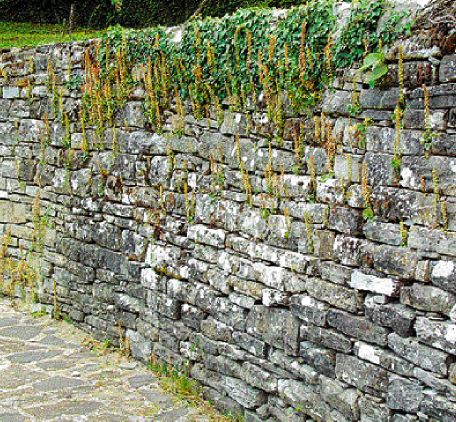 The village of Dholiani has in the past used beautiful stonework to prevent subsidence |
|
| I trudged to the place well outside the village, "with water and grazing", where they sent me. When the bit about grazing turned out to be an exaggeration, and the bit about water an outright lie, it was the last straw. I hardly know how to find the strength to walk back to the nearest house with my bucket. The man there was so kind that when I tried to thank him, I disconcerted him and myself by bursting into tears. I was still snivelling and gulping as I gave George water and apologised to him for the poor grazing. When a mare wants to calm a foal she puts her muzzle on its neck, just above the withers, quite firmly, and steadies it. That's what George did to me. Compassion for me, a mere yahoo, from that noblest of beings, my own dear Houyhnhnm. Unsustainable development |
||
The next day was no better. We were going along a nice Houyhnhnm track when suddenly it became slippery asphalt, and next thing we were on a main road with white lines, metal barriers and everything. And this road had been what we might euphemistically call "built", straight through the middle of the once picturesque village of Dholiani, which has some lovely stone buildings and a number of historic stone bridges. I stopped to have lunch and to hear their woes. "What has happened to you," I asked. "Don't ask," they said. |
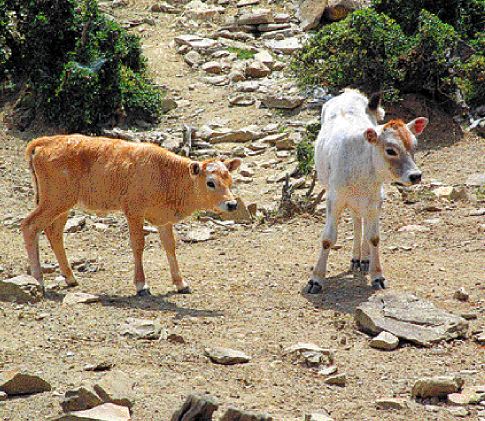 Two-colour morphs of the new breed of Agrinio cattle |
|
"But why did you let them do this? Why didn't you protest when you saw what was going on?" I asked naively. "We did. But there's not many of us, and if you make too much fuss, next thing you know you stop getting other things you need. "We know that the plans that went to Brussels for funding included a stone bridge. When we asked why there wasn't one, we were told there was no money. They just left the earth like that. Of course, it collapsed into the village after a storm." I bet it did. This village has in the past used beautiful stonework to prevent subsidence and to protect the road. So it can be done. It's just that it isn't done any more. "Up the road at Frangathes," they told me, "this hasn't happened." "Why?" "Because," they said, "at Frangathes there is someone bigger than the nomarchis - the prefect - to protect them, that's why." I got to Frangathes and, Yes! There is indeed some power greater than that of the nomarchis, and it can protect a village from the barbarians. |
||
| Strangely the new "improved" road didn't go through the centre of Frangathes, it didn't even go near enough to the village to harm it at all. If I was a person with enough clout to save Frangathes, I would use it to save all of the villages, not just the one where I had a house. The Kipi area, thank goodness, is not seen as ripe for development for some reason. It is delightfully unimproved. The people were kind and helpful. Michaelis has got a great taverna there. |
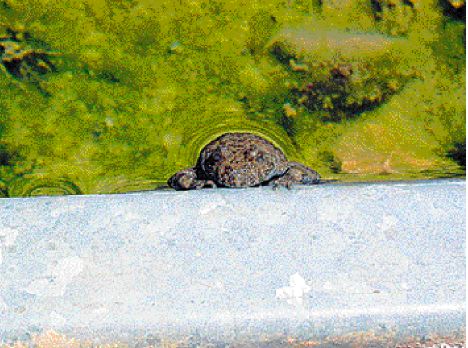 A yellow-bellied toad in the ideal environment of a water trough |
|
| I slept near a beautiful old bridge and woke up to the sound of nightingales and what I saw when I opened my eyes was grass gorgeously bejewelled with dew. It was like the relief of waking sweating from a nightmare and realising that it was only a dream. I wish. Equine thugs give George some grief |
||
I had hoped to get to Papingo by crossing Mt Tymfi from near Kipi, (both villages are in the part of Epiros known as Zagori) but villagers warned me that there was too much snow. This meant I had to go round instead of over the mountain. So we really had to move if we were to be in Papingo in time to leave George there with my friend, the lovely Dafne Dimou, (MSc in conservation biology, horse owner and trek leader, mountain guide and ex-member of the Greek women's soccer team) while I went to the SAVE (Safeguard for Agricultural Varieties in Europe) conference at Agrinio. |
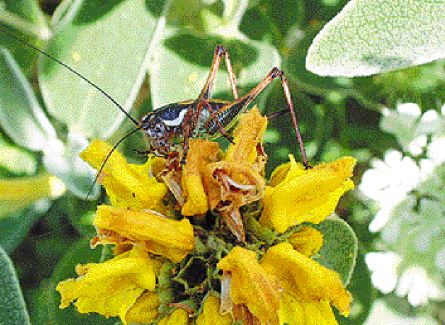 A colourful cricket, undisturbed by the photographer's gaze |
|
| Cordelia Madden has already written about that very important event, which will make a great difference to the future of rare breeds in Greece, and consequently to all our chances of getting healthy food. To find her article, essential reading for those who care about what is happening in Greek agriculture, go to www.athensnews.gr then search under her name. I`ll just add that after she left we went to see some local cattle which were then suspected of being, and are now proved to be, an old Greek breed. The local people knew about them, of course, but now the herd can be officially recorded and protected, plus the farmer who has preserved it will be able to get some kind of financial help. Which he needs. At the moment he gets a piddling two euros a kilo for his attractive cattle. They come in two colours, a kind of delicate apricot and a dusty grey. University studies in Greece, which purport to prove that virtually no old breeds of domestic animals survive in the country, will be confounded by this and other discoveries made by the members of the new non-governmental organisation called Amalthea, of which I am proud to be a founding member. |
||
| George was supposed to have spent these days in rest and recuperation, but in the area of Papingo there are about eighty feral horses. Four of these visited George one night, smashed their way into his more than adequately fenced paddock, beat him up and then left. So poor George had lost weight because of anxiety, and was covered in a variety of bumps and bruises. Dafne told me where to go to see chamois, of which there are about three hundred in the area. It seemed possible to cross Tymfi towards Grammos, taking in the grazing grounds of the chamois on the way. Alas it was not to be. When we had got pretty high up we met some Italian walkers, returning from an unsuccessful attempt to make the very crossing we were contemplating, driven back by snow. Well, if those tough-looking walkers couldn't get through, then I knew George would never make it. |
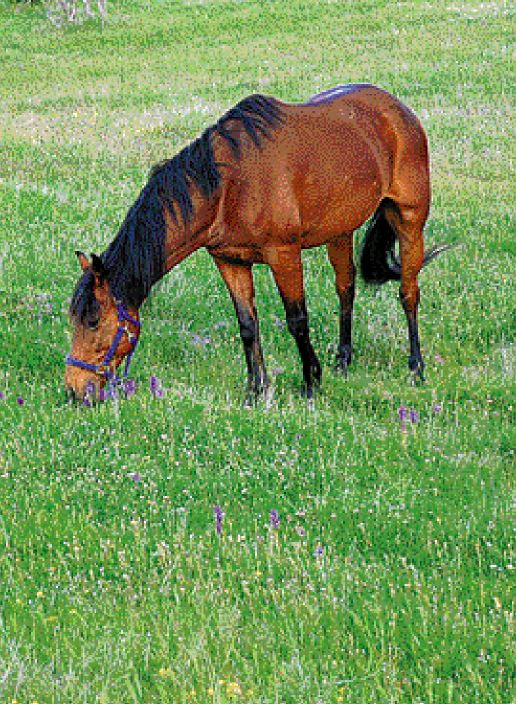 After being attacked by feral horses, George grazes amidst orchids |
|
Before we turned back to Papingo we rested. George grazed and I watched some yellow-bellied toads who were provided with an ideal environment by a water trough. These primitive, endearingly ugly little creatures may be my favourite amphibians. Their yellow bellies warn that they are nasty-tasting, and they are therefore less wary than their more delicious cousins. Uniquely, their skin exudes a kind of antibiotic. They live in pleasant harmony with each other and form pairs without the scrapping and violence that other types of frogs and toads indulge in. Dafne, mountain guide extraordinaire, showed us another route out of Papingo. We followed the "nice easy path" she suggested. It was too steep to ride up, so I was knackered when we got to Koula, and even George was sweating. But it was worth it, Dafne knows all the best places. A missed turn |
||
| The place George and I stopped for the night was magic. We were in an orchid filled meadow. There was interesting geology. A lime-stone pavement. There were huge mushrooms that looked like mooncraft. The next day we crossed into Konitsa over an old Turkish bridge, which was a bit scary, as it is steep, and you are very high above the river at the peak of the arc. After Konitsa there is a track that skirts Mount Smolikas and takes you to Grammos. Somehow we missed the turning. |
 A majestic view of the unreachable Mount Tymfi |
|
|
As dusk fell there were views of Mount Tymfi at its most majestic. I began to understand why we hadn't managed to cross it either going to, or coming from, Papingo. It got dark. At about ten o'clock, tired and hungry we got to Elefthero. "Is there anywhere I can stop where there is water and grass for the horse?" I asked. "Yes," they said, "you go along there till you come to the river." I found the place: more than adequate. I tethered George, got him some water from the river which was rushing noisily past and started back to the cafe. I met two guys on the road. "We were coming to tell you that a better place for your horse would be back this way," they said. So I got George and he came with us back to the cafe. There was a wonderful little meadow for him. I sat down and Spiro started to make me a meal. I overheard a conversation between a few of the old blokes who were sitting outside drinking beer. "Well, we couldn't just leave her, its our duty, as a village, to be hospitable." So sweet and kind. Read first article,"Trekking Across Greece's Wild West." View entire second story,"An Adrenaline Rush." |
||
|
(Posted 08 November 2006) HCS readers can view other excellent articles by this writer in the travel section of our extensive, permanent archives at the URL http://www.helleniccomserve.com./contents.html
All articles of Athens News appearing on HCS have been reprinted with permission. |
||
|
||
|
2000 © Hellenic Communication Service, L.L.C. All Rights Reserved.
http://www.HellenicComServe.com |
||

